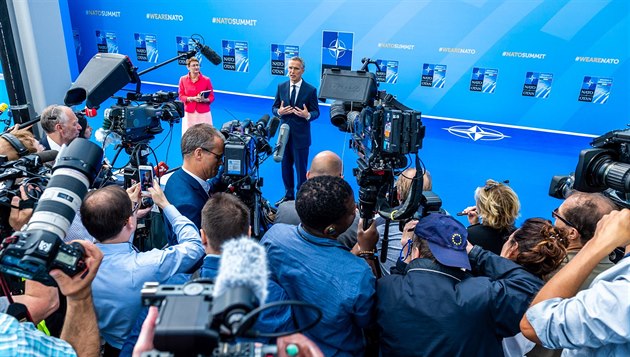Celý èlánek je dostupný na:
Trump Fumed, but NATO Members Got What They Wanted
Robbie Gramer, Lara Seligman
12.7. 2018, Foreign Policy (USA)
---
Au sommet de Bruxelles, Donald Trump n’a pas divisé l’Otan
Olivier Fourt
12.7. 2018, RFI
Si le président américain s’emploie à démonter toute forme de multilatéralisme depuis son arrivée à la Maison Blanche, l’Otan apparaît encore aujourd’hui comme l’alliance la plus robuste pour la sécurité de l’Europe depuis 1949, alors qu’elle était pourtant remise en cause – en tout cas militairement – à la chute de l’Union soviétique en 1991. Vingt-sept ans plus tard, l’Alliance atlantique permet toujours aux Etats-Unis de peser sur les décisions européennes et constitue un débouché habituel pour les armements américains, comme l’avion de combat F-35 que les Etats-Unis souhaitent voir adopter par leurs alliés européens.
---
Trump reafirma apoio à NATO depois de lançar o pânico
Rita Siza
12.7. 2018, Publico (Portugalsko)
Talvez nunca se venha a perceber exactamente o que se passou, mas quando os nervos se recompuseram do choque, e apesar do big-show de Donald Trump, não houve uma grande mudança no acordo que os líderes tinham ratificado na véspera em termos de partilha de custos e responsabilidades, apenas ligeiros acertos que não são de substância mas de calendário — que mesmo assim, continua a apontar para 2024 como a data em que todos terão de chegar ao patamar de 2% do PIB.
---
NATO Survives Trump, but the Turmoil Is Leaving Scars
Steven Erlanger, Julie Hirschfeld Davis, Katie Rogers
12.7. 2018, The New York Times (USA)
NATO, a pillar of the global order, emerged from a two-day confrontation with President Trump on Thursday intact but distracted and shaken, a further challenge to the alliance as it faces an expansionist Russia and growing authoritarianism among some of its own members.
---
Trump’s False Claims at NATO
Eugene Kiely, D’Angelo Gore, Robert Farley
12.7. 2018, FactCheck.org
The president falsely said “prior to last year” the amount other NATO countries spent on defense “was going down and down very substantially.” In fact, NATO Europe and Canada increased defense spending in 2015 and 2016.
Trump also was wrong when he said that “many countries [in NATO] owe us a tremendous amount of money for many years back, where they’re delinquent … because the United States has had to pay for them.” Countries in the alliance that spend less than 2 percent of their GDP on their own defense are not required to pay countries that do.
The president repeatedly claimed that “everyone has agreed to substantially up their commitment.” But leaders of several European nations later said there were no formal agreements to increase spending beyond previously set goals.
---
NATO’s 2% Target: Why the U.S. Pushed Allies to Spend More on the Military
Nancy A. Youssef, Michael R. Gordon
12.7. 2018, Wall Street Journal (USA)
Some critics say that too many countries were focused on the percentage of contributions and not the value of what NATO members were bringing to members’ collective security. The contributions of countries differ: Italy, for example, spent 1.1% of its GDP on its military in 2017, according to NATO, but runs the Western headquarters for international forces in Afghanistan and has trained police in Iraq. Estonia, the third-largest contributor in terms of GDP, doesn’t provide many troops or equipment but rather specializes in cyber defense. Greece exceeded the 2% goal, making its contributions to military spending only second to the U.S. But critics charge that Greece’s military spending is largely in personnel.
Two percent “was a goal post. It was initially very good because it got them thinking how much of their budget to spend on defense spending on how much not rely on others,” said Army Lt. Gen. Mark Hertling, who retired in 2012 as commanding general of U.S. Army Europe and the 7th Army. “But it’s not an accurate description of contribution NATO members make.”
---
Trump isn’t attacking NATO. He’s strengthening it.
Marc A. Thiessen
12.7. 2018, Washington Post (USA)
On Thursday President Trump suggested NATO members double their defense spending targets to 4 percent of GDP. This is not a gift to Russia, as his critics have alleged. The last thing Putin wants is for Trump to succeed in getting NATO to spend more on defense. And if allies are concerned about getting tough with Russia, there is an easy way to do so: invest in the capabilities NATO needs to deter and defend against Russian aggression.
---


 tisknout
tisknout